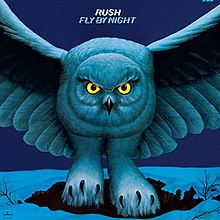The trio is born
 This record marks the true beginning of Rush. While the band produced a strong debut that garnered valuable attention, this was a band that still didn’t have a solid identity. Luckily, that potential problem would be ameliorated with the arrival of Neil Peart, a gifted drummer with a predilection for literature. Neil Peart’s gifts helped expand the band’s overall musicianship, and his abilities helped advance Geddy and Alex from being good musicians to absolutely fantastic musicians. Lifeson's solos are fiery and searing, Lee's bass lines are quicker, more rapid on the self-titled, and Peart's drumming is fast and unpredictable, but never messy, for the most part being in service to the tracks.
This record marks the true beginning of Rush. While the band produced a strong debut that garnered valuable attention, this was a band that still didn’t have a solid identity. Luckily, that potential problem would be ameliorated with the arrival of Neil Peart, a gifted drummer with a predilection for literature. Neil Peart’s gifts helped expand the band’s overall musicianship, and his abilities helped advance Geddy and Alex from being good musicians to absolutely fantastic musicians. Lifeson's solos are fiery and searing, Lee's bass lines are quicker, more rapid on the self-titled, and Peart's drumming is fast and unpredictable, but never messy, for the most part being in service to the tracks.
The puzzle pieces were slowly coming together on this
record, making “Fly by Night” a
quantum leap forward from the eponymous release.
However, one crucial element was being implemented that would change
Rush forever: Neil Peart’s writing. On
top of Peart’s background as a gifted drummer, his interests in literature,
more specifically the works of the founder of objectivism, Ayn Rand, would prove fundamental for expanding Rush’s lyrical
capabilities. On many of the tracks
Peart had a hand in writing on this album, there are numerous allusions to
literary and philosophical ideals that weren’t present in the debut. This drastic shift in lyrical focus
would be fundamental to the band’s identity. This band would now
pursue more thematically and philosophically rich topics and ideals, slowly
shedding away the standard rock n roll image that was exhibited in the
self-titled debut.
 In retrospect, Neil Peart’s writing on “Fly by Night” is
more direct, less subtle than what he would be capable of in the decades to
follow, but that earnest desire to explore more meaty topics gives his early
writing a sense of sincerity and charm. This desire is aggressively demonstrated
with the barn burner of an opening track “Anthem”. The track, taken from a novella written by Ayn Rand, is about the ideals of
individualism, with the song imparting to the listener that one must pursue their own goals. As
expressed in the latter half of the track, even though “they’ve always told you
selfishness was wrong”, it ultimately serves as a great benefit to society as a
whole, because those who seek what they desire bring for themselves and only
themselves bring forth the “wonders of the world”, or the art that people look
at with wonder. This idea of forging
your own path is presented again in the title track, “Fly by Night” one of Rush’s biggest commercial singles and a radio
rock staple. It presents a
situation of letting go and creating the life that you want to create. This direct tone is exhibited beautifully
with the verse “My ship isn’t coming and I just can’t pretend”. No one is going
to send you off to greater and better avenues and pathways, you have to steer
the ship yourself and get to the dreams that you desire and want to be
fulfilled.
In retrospect, Neil Peart’s writing on “Fly by Night” is
more direct, less subtle than what he would be capable of in the decades to
follow, but that earnest desire to explore more meaty topics gives his early
writing a sense of sincerity and charm. This desire is aggressively demonstrated
with the barn burner of an opening track “Anthem”. The track, taken from a novella written by Ayn Rand, is about the ideals of
individualism, with the song imparting to the listener that one must pursue their own goals. As
expressed in the latter half of the track, even though “they’ve always told you
selfishness was wrong”, it ultimately serves as a great benefit to society as a
whole, because those who seek what they desire bring for themselves and only
themselves bring forth the “wonders of the world”, or the art that people look
at with wonder. This idea of forging
your own path is presented again in the title track, “Fly by Night” one of Rush’s biggest commercial singles and a radio
rock staple. It presents a
situation of letting go and creating the life that you want to create. This direct tone is exhibited beautifully
with the verse “My ship isn’t coming and I just can’t pretend”. No one is going
to send you off to greater and better avenues and pathways, you have to steer
the ship yourself and get to the dreams that you desire and want to be
fulfilled. Individualism isn’t the only topic that is covered on this
record as the third track, “Beneath Between and Behind”, is a biting critique of the
ideal of the American Dream. The track
presents the often championed American ideal as corrupted and rotten, that
“behind the beauty, cracks appear”, and how the American Dream’s
positive ideals of progression can lead to destruction. This allusion is presented with the final
verse before the chorus, discussing how “the guns replace the plow, facades are
tarnished now, [and] principles have been betrayed.” Pear's writing is direct and blunt, and it allows the track to feel more organic and a
warning, while avoiding devolving into the realms of being preachy. In
my opinion, "Beneath Between and Behind" is an overlooked track that needs to be discussed more often in regards to Rush’s
impressive library of songs.
Individualism isn’t the only topic that is covered on this
record as the third track, “Beneath Between and Behind”, is a biting critique of the
ideal of the American Dream. The track
presents the often championed American ideal as corrupted and rotten, that
“behind the beauty, cracks appear”, and how the American Dream’s
positive ideals of progression can lead to destruction. This allusion is presented with the final
verse before the chorus, discussing how “the guns replace the plow, facades are
tarnished now, [and] principles have been betrayed.” Pear's writing is direct and blunt, and it allows the track to feel more organic and a
warning, while avoiding devolving into the realms of being preachy. In
my opinion, "Beneath Between and Behind" is an overlooked track that needs to be discussed more often in regards to Rush’s
impressive library of songs. While these lyrical explorations are indeed noteworthy, the
most important track on the record is the eight-minute-long multi-part track,
“By-Tor and the Snow Dog”. Unlike the
other tracks that have been discussed, this song’s creation comes from a
humorous scenario. Rush’s roadie was staying at their manager’s house one time
and the manager’s dogs were growling and trying to jump on him, and from there
the song was crafted. The track doesn’t have
any other lyrical weight to it other than that and it serves more
as a method for the band to demonstrate their capabilities. This track, while fun and definitely exciting
to hear the many different techniques the trio implements, I wouldn’t be
surprised nor disagree if a newcomer described the track as “self-indulgent”. Despite my appraisal I enjoy "By-Tor" immensely, but compared
to the other multi part tracks the band would undertake, this is the roughest,
most simple “epic” that they crafted in their career.
While these lyrical explorations are indeed noteworthy, the
most important track on the record is the eight-minute-long multi-part track,
“By-Tor and the Snow Dog”. Unlike the
other tracks that have been discussed, this song’s creation comes from a
humorous scenario. Rush’s roadie was staying at their manager’s house one time
and the manager’s dogs were growling and trying to jump on him, and from there
the song was crafted. The track doesn’t have
any other lyrical weight to it other than that and it serves more
as a method for the band to demonstrate their capabilities. This track, while fun and definitely exciting
to hear the many different techniques the trio implements, I wouldn’t be
surprised nor disagree if a newcomer described the track as “self-indulgent”. Despite my appraisal I enjoy "By-Tor" immensely, but compared
to the other multi part tracks the band would undertake, this is the roughest,
most simple “epic” that they crafted in their career. This roughness I describe is exhibited throughout the record. One of the biggest flaws of "Fly By Night" is the sharp contrast between the songs Peart wrote and the ones written by Lee or Lifeson. Lee and Lifeson written tracks such as “Best I Can” and “Making Memories”, while having very tasty riffs and choruses, are songs that are incredibly simple in lyrical approach. These are tracks about being a rock n roll star, or having fun while touring, which is harsh juxtaposition from songs such as "Anthem" or "Fly By Night". Even Peart isn’t completely free from this flaw, as the second to last track he wrote entitled “Rivendell” is a fairly jarring change of style from the rest of the record. Despite the tonal whiplash, I feel it’s a very pleasant track that is entrenched in a beautiful atmosphere, even if it is a track that showcases how much of a nerd Neil Peart is about Tolkien. The album concludes triumphantly with “In The End” which has an acoustic beginning before breaking into this thunderous Jimmy Page like riff, even if lyrically it isn’t that spectacular, but that aside, it is a very good track to end the record.
This roughness I describe is exhibited throughout the record. One of the biggest flaws of "Fly By Night" is the sharp contrast between the songs Peart wrote and the ones written by Lee or Lifeson. Lee and Lifeson written tracks such as “Best I Can” and “Making Memories”, while having very tasty riffs and choruses, are songs that are incredibly simple in lyrical approach. These are tracks about being a rock n roll star, or having fun while touring, which is harsh juxtaposition from songs such as "Anthem" or "Fly By Night". Even Peart isn’t completely free from this flaw, as the second to last track he wrote entitled “Rivendell” is a fairly jarring change of style from the rest of the record. Despite the tonal whiplash, I feel it’s a very pleasant track that is entrenched in a beautiful atmosphere, even if it is a track that showcases how much of a nerd Neil Peart is about Tolkien. The album concludes triumphantly with “In The End” which has an acoustic beginning before breaking into this thunderous Jimmy Page like riff, even if lyrically it isn’t that spectacular, but that aside, it is a very good track to end the record.“Fly By Night” is a transitionary album, with the band’s feet being stuck in the simple hard rock mindset of the previous album, and the more forward-thinking approach that would be further fleshed out in the future. However, the record itself was a success for them, and “the new guy” really proved himself and aspirations were running high. They released another record in the same year as “Fly By Night” and, unfortunately, their progress came to a screeching halt.

Comments
Post a Comment